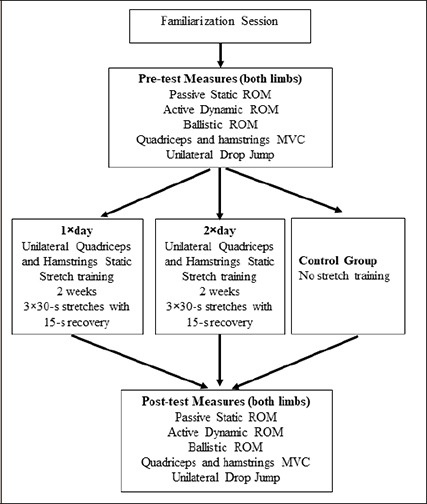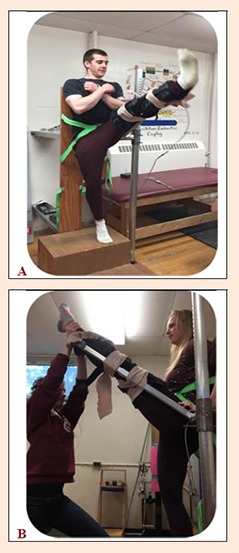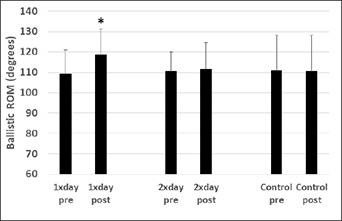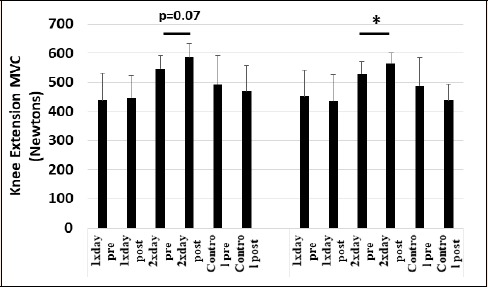Abstract
Currently there are recommendations for stretching type, repetitions and duration within a training session to improve flexibility. It is, however, unclear whether multiple daily stretch training sessions provide greater flexibility than single daily sessions. The objective was to investigate the effectiveness of single (1×day) versus twice daily (2×day) unilateral stretch training sessions on hip flexion range of motion (ROM), agonist and antagonist force and jump performance of the stretched and contralateral, non-stretched legs. Groups included a control, 1×day and 2×day stretch training groups. Static stretching (SS) involved self-administered (stretch band), unilateral, hamstrings and quadriceps stretching for 2-weeks. Pre- and post-testing involved hip flexion ROM, knee extension and flexion maximal voluntary isometric contraction (MVIC) forces and unilateral drop jumps (DJ). The 2×day group showed a 12.8% (p = 0.08) greater active ROM versus Control. The 1×day group showed a 7.5% (p=0.1) ballistic ROM increase with no significant changes with the 2×day and Control groups. The stretched leg experienced a 5.01% (p = 0.1) hip flexion ballistic ROM increase contrasting with a 2.3% increase for the contralateral leg. Twice daily training provided 7.1% (p = 0.07) and 6.6% (p = 0.01) quadriceps MVC force increases of the stretched trained and contralateral legs respectively. Contralateral DJ height improved 22.6% (p = 0.002) with 2×day training. In conclusion, 1xday and 2×day stretch training tended to improved ballistic and active ROM respectively, whereas 2×day training improved MVIC force and DJ height. The findings may apply to fitness enthusiasts and rehabilitation as unilateral stretching may retain performance and active ROM of the stretched and contralateral limbs.
Key points.
Stretch training 2×day improved the stretch-trained quadriceps MVC force, DJ contact time, and active ROM as well as contralateral leg quadriceps MVC force and DJ height.
Stretch training 1×day improved contralateral ballistic hip flexion ROM and the stretch trained leg DJ contact time.
Self-administered flexibility training programs with stretch bands may contribute to strength and power gains with recreationally active individuals, however periodic recovery days may be needed to optimize improvements in ROM.
Key words: Flexibility, stretch frequency, strength, power, crossover effect
Introduction
Flexibility training has been shown to improve joint ROM (Behm, 2018; Behm et al., 2016a; Behm and Chaouachi, 2011), muscle performance (Behm, 2018; Medeiros and Lima, 2017), and enhance rehabilitation progress for injured or mobility impaired individuals (Andrews, 2012). Static stretch (SS) training is often recommended for athletes, fitness enthusiasts and recreationally active individuals to decrease musculotendinous injuries, especially with high velocity, explosive and change of direction activities (Behm, 2018; Behm et al., 2016a), while physiotherapists often implement SS for their patients (Decoster, 2009).
While these benefits have been shown with SS training programs that typically involve SS 3-5 days per week for 3-10 weeks (Behm, 2018; Medeiros and Lima, 2017), there are few studies that have employed daily SS. Mahieu et al. (2007; 2009) employed daily stretching for 6-weeks and found 11.5%-20.8% ROM increases with the plantar flexors and dorsiflexors. Few studies have instituted daily, multiple stretch training sessions. Rancour et al. (2009) reported enhanced hip ROM following 4-weeks of twice daily hamstrings SS of 2-minutes duration per leg. Levenez et al. (2013) had participants SS thrice daily for 30 seconds each for 5-weeks and found an improvement in drop jump height. Both Blazevich et al. (2014) and Kubo et al. (2002) did not find any significant change in plantar flexors peak torque following twice daily stretch training for 3-weeks with 4×30-s and 5×45-s stretch durations respectively. In contrast, Abdel-aziem and Mohamed (2012) incorporated twice daily SS training, 5 days per week for 6-weeks and reported increased plantar flexors eccentric and concentric peak torques. Thomas and colleagues (2018) in their review suggested a time dependency to stretching benefits with greater total durations providing greater ROM improvements. They recommended a minimum duration of 5-minutes of stretching per week performed 5 days per week. None of these studies directly compared single versus multiple daily SS training sessions. It is unknown whether multiple SS training sessions induce greater improvements in ROM, strength and power than single sessions.
Acute stretching sessions have demonstrated non-local or global effects of stretching. For example, unilateral hamstrings SS increased the contralateral hamstrings (hip flexion) ROM (Chaouachi et al., 2017). Hip adductors SS or dynamic stretching improved shoulder horizontal abduction ROM whereas shoulder flexion stretches increased hip flexion ROM (Behm et al., 2016b). Wicke et al. (2014) reported significant hips, back and shoulders ROM improvements following hamstrings SS. While many studies have reported SS-induced impairments of the stretched muscle groups (Behm, 2018; Behm et al., 2016a; Behm and Chaouachi, 2011), there is conflicting research regarding the effect of unilateral SS on non-local muscles. There are reports of no significant global (non-local) SS-induced contralateral balance impairments after plantar flexors SS (Lima et al., 2014), no significant deficits with contralateral homologous (quadriceps) isokinetic torque or power (Chaouachi et al., 2017), and no decrements in knee extension isometric maximum voluntary contraction (MVC) force output following contralateral quadriceps and hamstrings SS (Behm, 2019). In contrast, Marchetti et al. (2014) illustrated increased lower body propulsion duration (performance detriment), while da Silva et al. (2015) showed decreased force after shoulder SS and impaired contralateral jump height and impulse after unilateral plantar flexor SS. There are no studies examining global or non-local SS training (chronic rather than acute) effects. Furthermore, the conflicting findings regarding global SS-induced strength impairments suggest that continued investigations are necessary. Such crossover investigations provide insight into the neural versus mechanical mechanisms underlying SS-induced changes in ROM or muscle performance (i.e. strength and power).
Hence, the objective of this study was to investigate the effects of a once versus twice daily, 2-week quadriceps and hamstrings SS program on passive static, active dynamic and ballistic ROM as well as knee extension and flexion MVC and drop jump parameters. A second objective was to examine the effect of such a SS training program on potential crossover effects on the same flexibility and muscle performance measurements.
Methods
Participants
An “a priori” statistical power analysis (software package, G * Power 3.1.9.2) was conducted based on related studies (Behm et al., 2016b; Behm, 2019; Chaouachi et al., 2017) to achieve an alpha of 0.05 and a power of 0.8. The analysis indicated that between 8-10 participants per group were sufficient to achieve adequate statistical power. The current study consisted of male (n = 12) and female (n = 18) healthy, recreationally active (non-competitive activities on average 2-3 times per week for fitness and health), participants between the ages of 20 and 47 (22.47 ± 5.1). There were no significant anthropometric or activity level differences between the three groups (Table 1). Participants were recruited using a snowball sampling technique and using controlled randomization were divided into three groups: two SS trained groups (once and twice daily) and a control group, with 10 participants in each group (4 males per group and 6 females per group). Exclusion criteria included pre-existing health conditions, such as musculoskeletal injuries in the past six months or unable to properly perform the stretches involved in the study. Prior to testing, all participants were provided with information regarding the nature of the study, the requirements upon participation in each data collecting session. This study received ethical approval from the institution’s Interdisciplinary Committee on Ethics in Human Research (ICEHR: 20190627-HK).
Table 1.
Participant characteristics. Mean ± SD (standard deviation).
| Groups | Age (yrs) | Height (m) | Mass (kg) |
|---|---|---|---|
| Once daily stretch training | 22.60 ± 2.7 | 1.73 ± .09 | 74.27 ± 15.8 |
| Twice daily stretch training | 20.50 ± 0.85 | 1.64 ± .07 | 73.43 ± 16.7 |
| Control | 21.4 ± 3.8 | 1.70 ± 1.00 | 76.1 ± 18.2 |
Experimental protocol
To assess the effect of daily SS frequency over a 2-week training period on hip flexion passive static, active and ballistic ROM, knee extension and flexion MVC force and drop jump performance in both the stretched and unstretched, contralateral limbs, participants were randomly allocated into a once daily (1×day), twice daily (2×day) training, or a control group (Figure 1). Half of the participants in each experimental group were assigned to SS their right hamstrings and quadriceps, while the remaining participants SS the contralateral leg. Participants attended pre- and post-test sessions lasting approximately 30 minutes each. Two pre-tests with 15 minutes recovery were conducted to assess the reliability of the measures. Data recorded during the second pre-test was used for analysis to mitigate the effects of multiple testing sessions on ROM (Behm, et al. 2016a). Pre- and post-tests were separated by a 2-week training or 2-week control (no stretching) period. Prior to commencing the testing protocols each participant was required to provide signed consent, indicate their activity level, record age and anthropometric characteristics, and undergo a 5-minute warm up on an Ergomedic cycle ergometer (Monark Ltd, Sweden) at 70 revolutions per minute and one kilopascal (kPa). Test measures included passive static, active and ballistic hip flexion ROM, unilateral knee extension and flexion MVC force, and a unilateral drop jump test. The order of MVC and drop jump tests were randomized, with ROM measures tested last to avoid any strength or power impairments that might possibly be induced by the passive SS test. The order of the passive static, active and ballistic ROM were randomized.
Figure 1.

Experimental design.
Stretch training intervention
An extensive familiarization session was conducted prior to testing to ensure the participants were well informed of the testing and stretch training procedures and stretch training intensity. The 2-week training intervention undergone by the stretch training groups consisted of hamstrings and quadriceps SS held for 30-seconds and repeated 3-times per session with 15-seconds rest between repetitions. Hamstrings stretches were performed from a supine position using an elastic stretch band (TheraBand stretch band: Performance Health Inc., Akron Ohio) positioned over the arch of the foot. The participant actively assumed a flexed hip, extended knee, dorsiflexed position and with the aid of the stretch band actively flexed the hip to the point of maximal discomfort. Quadriceps stretches were performed as a side lying stretch with the band looped around the ankle. Participants actively assumed a hip extension, knee flexion, plantar flexed position and with the aid of the stretch band extended the hip to the point of maximal discomfort. Stretch training was performed at the participant’s home without direct researcher supervision. Researchers consistently (2-3 times per week) contacted the participants to enhance training compliance. There were no reports of missed training sessions.
Testing measures
Testing was conducted pre-training as well as 2 or 3 days following the 2-week training program. For hamstrings and quadriceps MVC force measures, a cuff with a non-extensible strap was attached to a strain gauge and placed around the ankle of the participant. Knee joint angles were measured using a goniometer with both knee extension (89.48 ± 3.6°) and knee flexion (115.31 ± 4.65°) positions. Four-second knee extension and flexion MVCs were performed with the participants arms crossed over their chest. Each leg was tested twice in an alternating pattern and a third measure was obtained if more than a 5% increase occurred from the first to second MVC. Verbal encouragement was provided during MVC trials to maximize participant motivation and subsequent force output. Andreacci et al. (2002) used verbal encouragement and found that a maximal effort was more likely to occur with verbal encouragement rather than without. Peak force output of the highest force trial was recorded for statistical analysis. (BioPac AcqKnowledge data acquisition and analysis system: DA 150: analog-digital converter MP100WSW, Holliston, MA).
Drop jump performance was assessed using a single leg, drop jump from a platform height of 30 cm. Participants were encouraged to jump with the shortest possible contact time (i.e. explosively) and maximum jump height. The jump was performed akimbo and participants landed on an electronic contact mat (Smart Jump, Fusion Sport, Chicago, Illinois), that provided calculated measures of contact time and jump height from the associated software. Each leg was tested twice in an alternating pattern, and peak values for height and shortest contact times were recorded for statistical analysis.
Measures of hip flexion ROM were obtained for ballistic, active dynamic and passive static ROM using an electronic goniometer (Technical Services Memorial University of Newfoundland, St. John’s, Newfoundland, Canada) and associated software (BioPac AcqKnowledge data acquisition and analysis system: DA 150: analog-digital converter MP100WSW, Holliston, MA). A knee brace was secured to the tested limb to ensure the knee was maintained in an extended position. For ballistic ROM measures, participants were instructed to perform a maximal hip flexion kick as explosively as possible (Figure 2a).
Figure 2.

(A) Photo of dynamic range of motion test with knee brace to maintain knee extension. The movements were similar for both active dynamic and ballistic ROM however, active dynamic was performed slowly and under more control while the ballistic was performed with an explosive contraction. (B) Photo of researcher-assisted static passive ROM with knee brace to maintain knee extension.
Active dynamic ROM required participants to actively lift their leg (hip flexion) with control and pause briefly at their perceived point of discomfort before returning to resting position (Figure 2a). Typically this movement had a duration of approximately 1-2 seconds. Passive static ROM measures were obtained with the facilitation of a researcher. The participant was instructed to relax their leg as the researcher lifted the leg vertically (hip flexion) until the participant verbally indicated the point of discomfort was reached (Figure 2b). All measures were taken twice on each leg and a third measure was obtained if a greater than five percent difference was calculated. The participants’ tested leg was strapped to the lever arm of the electronic goniometer. Participants were in a standing position with their arms across their chest and their torso was supported with crossbody straps.
Statistical analysis
Statistical analyses were completed using the SPSS software (Version 24.0, SPSS, Inc. Chicago, IL). First, normality (Kolmogorov–Smirnov) and homogeneity of variances (Levene) tests were conducted for all dependent variables. If the assumption of sphericity was violated, the Green-house-Geisser correction was employed. A mixed model repeated measures ANOVA was used to analyze the data. The absolute values from the stretch trained and non-stretched, contralateral legs were analyzed separately with 2-way ANOVAs, which involved 3 groups (1×day, 2×day, and control) x 2 times (pre- and post-stretch training program). To compare the relative changes between legs, values were normalized to the pre-test values and a 2-way ANOVA involving 3 groups (1×day, 2×day, and control) x 2 legs (stretch trained and non-stretched contralateral leg) was performed. Paired t-tests with Holm–Bonferroni corrections were used to decompose significant interactions, and Bonferroni post hoc tests were used if main effects were found. Significance was set at p ≤0.05. Cohen’s d effect sizes (ES) were also calculated to compare all measures. Effect size (d) magnitude of change were calculated for interactions and reported as trivial (<0.2), small (0.2-0.49), medium (0.5-0.79) or large (≥0.8) effect sizes (d) (Cohen 1988). Inter-session reliability responses were assessed with Cronbach's alpha intraclass correlation coefficient (ICC). Data is reported as mean ± SD.
Results
Reliability
Reliability measures from the two pre-tests assessed with the Cronbach alpha ICC were consistently excellent (0.82-0.96) with the exception of passive static ROM of the stretched leg (r = 0.79). Specific ICC values are provided in Table 2.
Table 2.
Reliability assessed with Cronbach alpha Intraclass Correlations (ICC). ROM: range of motion, MVIC: maximum voluntary isometric contraction.
| Stretched Trained Leg | Contralateral Leg | |
|---|---|---|
| Static Passive ROM | 0.79 | 0.91 |
| Active ROM | 0.82 | 0.92 |
| Ballistic ROM | 0.85 | 0.89 |
| Hamstrings MVIC force | 0.94 | 0.95 |
| Quadriceps MVIC force | 0.95 | 0.96 |
| Drop Jump Height | 0.91 | 0.90 |
| Drop Jump Contact Time | 0.94 | 0.96 |
Static passive hip flexion ROM
Both the stretched and contralateral hip flexion static passive ROM exhibited near significant and significant main effects for time with 5.2% (p = 0.1, d = 1.8) and 5.9% (p = 0.04, d = 2.1) increases from pre-test (Stretched: 114.4° ± 3.15; Contralateral: 113.4° ± 3.07) to post-test (Stretched: 120.40 ± 3.57; Contralateral: 120.2° ± 3.53) respectively. There were no significant between group interactions nor normalized (relative changes between legs) main effects or interactions.
Active hip flexion ROM
Whereas there were no significant main effects or interactions for the contralateral active ROM measures, the stretch trained hip flexors demonstrated near significant and significant main effects for training groups and time respectively. A main effect for time illustrated a 6.6% (p = 0.02, d = 2.4) increase in active ROM from pre- (86.4° ± 2.15) to post-test (92.2° ± 2.50). Main effects for training groups showed a near significant 12.8% (p = 0.08, d = 2.8) greater active ROM with the twice a day training group (94.5° ± 3.36) versus the Control (83.8° ± 4.17), but no significant, but large magnitude (d = 1.7) difference with the 1xday group (89.7° ± 2.15). There were no significant between group interactions nor normalized (relative changes between legs) main effects or interactions.
Ballistic hip flexion ROM
A significant training frequency by time interaction demonstrated that the 1xday training program provided a 8.7% (p = 0.04, d = 0.75) improvement in contralateral ballistic hip flexion ROM from pre- (109.1° ± 11.9) to post-test (118.5° ± 12.9) (Figure 3). A significant main effect for time with the stretched leg was found with a 5.8% (p = 0.01, d = 2.4) ballistic ROM increase from pre- (109.3° ± 2.10) to post-test (115.7° ± 3.14).
Figure 3.

Frequency x time interaction for contralateral leg ballistic hip flexion range of motion (ROM). 1xday: Static stretch training of contralateral leg once daily for 2-weeks, 2xday: Static stretch training of contralateral leg twice daily for 2-weeks. Asterisk represents significant difference between 1xday pre- and post-test ROM.
Normalized data showed near significant training frequency x leg interaction and a main effect for legs. The interaction for the contralateral, non-stretched leg revealed that the 1xday training group showed a 7.5% (p = 0.1, d = 0.7) increase from pre- to post-test compared to 0.05% increase and 0.6% decrease with the 2xday and Control groups respectively. The main effect indicated that the stretched leg experienced a 5.01% (p = 0.1, d = 0.3) pre-to post increase contrasting with a 2.3% hip flexion ROM increase for the contralateral leg.
Hamstrings MVC
There were no significant findings with hamstrings MVC force.
Quadriceps MVC
A near significant training frequency by time interaction (p = 0.07, d = 0.8) of the stretched trained leg revealed that the 2×day training group experienced 7.1% quadriceps MVC force increase from pre- (546.5 N ± 46.92) to post-test (585.3 N ± 48.39) (Figure 4). Similarly, the contralateral untrained leg showed a significant 6.6% (p = 0.01, d=0.9) increase in MVC force with the 2×day training program (Pre-test: 528.8 N ± 41.66 vs. Post-test: 564.06 N ± 36.61) Figure 3). Both the stretched trained and contralateral legs exhibited main effects for training frequency with greater values for the 2×day training. The 2xday training provided 47.9% (p = 0.01, d = 1.6) and 28.04% (p = 0.08. d = 0.7) significantly greater MVC forces with stretched trained leg than with Control or 1xday training respectively (pre- and post-test data combined). The effect of 2×day training on the contralateral leg (546.4 N ± 37.54) resulted in 33.7% (p = 0.01, d = 4.7) and 22.9% (p = 0.07, d = 3.1) greater MVC forces than with the Control (408.6 N ± 19.91) and 1xday training (444.3 N ± 27.68) groups respectively (pre- and post-test data combined).
Figure 4.

Frequency x time interaction for knee extension MVC forces. Asterisks represent significant differences between 2xday pre- and post-test.
The normalized values demonstrated main effects for interventions (p = 0.05, d = 0.4) and legs (p = 0.05, d = 0.6). Whereas the 2×day training experienced a 6.7% increase, 1×day and Control showed 1.1% and 12% decrements. Main effects for trained leg with the stretch trained leg experiencing an overall (includes both training frequencies and control data) 0.42% increase in contrast to the overall 4.8% decrease in the contralateral leg.
Drop Jump (DJ) Height
A significant frequency × time interaction of the contralateral leg revealed that the 2×day stretch training provided a 22.6% (p = 0.002, d = 0.9) increase in DJ height from pre- (10.1 cm ± 2.30) to post-test (12.4 cm ± 2.21) (Figure 5). Both the stretch trained (p = 0.01, d = 1.3) and contralateral (p = 0.03, d = 1.0) legs showed main effects for time with 13.7% (stretch trained: p = 0.03; pre-test: 10.2 cm ± 1.06 vs. post-test: 11.6 cm ± 1.12) and 13.0% (contralateral: p = 0.02; pre-test: 10.4 cm ± 1.27 vs. post-test 11.7 cm ± 1.31) improvements respectively.
Figure 5.

Frequency x time interaction for contralateral drop jump height. Asterisk represents significant pre- to post-test increase for 2xday.
Drop Jump (DJ) contact time
A near significant (p = 0.1) frequency x time interaction of the stretch trained leg indicated that the 1×day and 2×day stretch training programs decreased DJ contact time from pre- to post-test by 4.5% (d = 0.2) and 6.3% (d = 0.3) respectively whereas the Control group had a 2.7% prolonged DJ contact time. The stretch trained leg also exhibited a main effect for time with a 2.7% (p = 0.01, d = 0.7) shorter DJ contact time from pre- (334.4 ms ± 13.46) to post-test (325.3 ms ± 12.93). The normalized data revealed that the stretch trained leg experienced a 2.8% (p = 0.01, d = 0.15) reduction in DJ contact time in contrast to 1.3% increase with the contralateral leg.
Discussion
The most important findings in the present study were that stretch training 2×day improved the stretch-trained quadriceps MVC force, DJ contact time, and active ROM while also benefiting the contralateral leg quadriceps MVC force and DJ height. Stretch training 1xday improved contralateral ballistic hip flexion ROM and the stretch trained leg DJ contact time. The normalized (relative to pre-test) data demonstrated that the stretch trained leg experienced superior gains for ballistic ROM, quadriceps MVC force and DJ contact time. Surprisingly, while the two stretch training frequencies increased passive static, active and ballistic hip flexion ROM, the gains were not significantly greater than the control group with the exception of stretch trained leg active ROM and contralateral leg ballistic ROM.
The lack of improvement in passive static ROM following two weeks of daily stretching is in contrast to stretch training studies that stretched 3-5 days per week (see reviews: Behm, 2018; Medeiros and Lima, 2017), as well as the few studies that employed daily stretching. Once per day stretching for six weeks increased plantar flexors and dorsiflexors ROM by 11.5%-20.8% (Mahieu et al., 2007; 2009). Four weeks of twice daily hamstrings SS of 2 minutes duration per leg improved hip ROM by 26.8% (Rancour et al., 2009). However, in accordance with the present study, Roberts and Wilson (1999) found an improvement in active ROM but not passive static ROM following a 3 days per week, 5-week stretch training program. A possible explanation for the lack of passive static ROM improvements could be related to training specificity. The stretch training exercises were performed while either supine or laying on their side, whereas, the testing was performed while erect. Although the individuals were strapped and could lean against the electronic goniometer when tested, they had to stand on one leg. This unilateral position would have activated the postural muscles such as the soleus and trunk muscles to a greater degree (Anderson and Behm, 2005; Behm et al., 2010a; 2010b) than when stretching in a supine position. The activation of these muscles could be transferred globally to non-local muscles such as the contralateral hamstrings and gluteal muscles (Andrews et al., 2016; Halperin et al., 2015), which could have restricted the tested ROM.
The training-induced improvements in quadriceps MVC and drop jump performance may be related to the extent of hip extension and flexion ROM. There was no significant improvement in hamstrings MVC force. Hamstrings’ flexibility would play an important role in hip flexion ROM, which is reported to range from 100-1300 (Behm 2018). In contrast, hip extension ROM is reported to range from 10-300 (Behm 2018). Stretching or elongating the hamstrings through a much greater ROM with hip flexion, daily for 2-weeks, may have placed greater tensile stresses on the hamstrings compared to the limited ROM or lengthening of the quadriceps. Hence, it is possible that higher daily strain on the hamstrings could have produced some muscle strain affecting both hamstrings MVC force and passive static ROM.
However, flexibility gains were evident with stretch trained leg active ROM (2×day) and contralateral ballistic ROM (1×day). These gains may be related to the quadriceps strength and power improvements seen with the stretch training program. Stretch training 2×day improved the stretch-trained quadriceps MVC force, and DJ contact time as well as the contralateral leg quadriceps MVC force and DJ height. As well, a decreased DJ contact time would be related to the increased strength capabilities that would allow for a shorter landing or absorption phase.
The ability to increase dynamic active or ballistic ROM is reliant not only on the musculotendinous compliance and reflex inhibition of the stretched muscle (Behm, 2018; Behm et al., 2016a; Behm and Chaouachi, 2011), but also the force (active ROM) or power (ballistic ROM) of the hip flexor muscles used to move the leg through a greater ROM. While the static ROM test was passive and the exerted force controlled by the researcher, the increased strength and power of the hip flexors provided a significantly greater impetus to promote an increased active and ballistic hip flexion ROM.
Strength and power improvements with a stretch training program with no supplemental strength or power training might not be expected. However there are a number of other stretch training studies that have also reported strength and power gains. Levenez et al. (2013) reported drop jump height improvements with a 5-week, 3×day stretch training program. A 6-week, 5 days per week, 2×day stretch training program resulted in increased plantar flexors eccentric and concentric peak torques (Abdel-Aziem and Mohammad, 2012). While not all daily stretch training routines have found strength improvements (Blazevich et al., 2014; Kubo et al., 2002), a unique aspect of this study was the use of a self-administered stretch training program using stretch bands. Participants would have to actively contract their hip flexors and hip extensors to initially place their legs in a position to be stretched further with the stretch bands. Secondly, the participants might have actively contracted these muscles in conjunction with the bands to facilitate a greater ROM or could have contracted against the stretch band. Nonetheless, it seems evident that the self-administered stretching with stretch bands involved greater muscle activity than the typical passive static stretching activities.
However, this active, stretch band assisted, stretching routine was unilateral and as such why would increases in contralateral ballistic ROM, knee extension MVC force and drop jump height occur? Cross education training effects are widely reported in the literature (Ben Othman et al., 2018; Carroll et al., 2006; Farthing et al., 2007) and thus it would not be unexpected that contralateral strength gains could occur. Training-induced improvements in motor unit recruitment, rate coding, synchronization, and motor control (i.e. increased synergistic contributions and decreased co-contractions) can have global implications (Behm, 1995) and thus, such training adaptations would not have been limited to the stretch trained limb. In accord, with the cross education literature (Ben Othman et al., 2018; Carroll et al., 2006; Farthing et al., 2007), the training gains were of a greater magnitude with the trained versus the untrained contralateral leg. Whereas the contralateral leg training improvements are commonly attributed to neural adaptations, the trained leg may have experienced both neural and muscle adaptations.
A limitation of the present study was that participants completed the stretching protocol during their own time away from the laboratory. Since the participants were not completing the protocol under the constant examination of a researcher it was difficult to know if they followed the protocol exactly. However, the participants were given a thorough familiarization and were contacted 2-3 times per week to encourage compliance. There were no reports of missed sessions.
Conclusion
In conclusion, stretch training 2×day improved the stretch-trained quadriceps MVC force, DJ contact time, and active ROM as well as contralateral leg quadriceps MVC force and DJ height. Stretch training 1×day improved contralateral ballistic hip flexion ROM and the stretch trained leg DJ contact time. The normalized data demonstrated that the stretch trained leg experienced superior gains for ballistic ROM, quadriceps MVC force and DJ contact time. While the lack of passive static ROM gains might be attributed to training specificity or inadequate recovery periods, the increased strength and power adaptations could have contributed to improve active and ballistic ROM. Even without constant supervision, the use of stretch bands for a self-administered flexibility training program may contribute to strength and power gains with recreationally active individuals, however periodic recovery days may be needed to optimize improvements in ROM. Two daily stretching sessions may be more advantageous for MVC force gains that single sessions.
Acknowledgements
The study comply with the current laws of the country in which were performed. The authors report no conflict of interest.
Biographies

Sarah CALDWELL
Employment
Undergraduate student
Degree
Bachelor of Kinesiology
Research interest
Exercise and rehabilitative sciences
E-mail: slc128@mun.ca

Reagan BILODEAU
Employment
Undergraduate student
Degree
Bachelor of Kinesiology
Research interest
Exercise and rehabilitative sciences
E-mail: rlsb34@mun.ca

Megan J. COX
Employment
Undergraduate student
Degree
Bachelor of Kinesiology
Research interest
Exercise and rehabilitative sciences
E-mail: mjc547@mun.ca

David G. BEHM
Employment
University Research Professor
Degree
PhD
Research interest
Neuromuscular physiology and sport
E-mail: dbehm@mun.can
References
- Abdel-Aziem A.A., Mohammad W.S. (2012) Plantar-flexor Static Stretch Training Effect on Eccentric and Concentric Peak Torque - A comparative Study of Trained versus Untrained Subjects. Journal of Human Kinetics 34, 49-58. [DOI] [PMC free article] [PubMed] [Google Scholar]
- Alter M.J. (1996) Science of Flexibility. Champaign Illinois: Human Kinetics. [Google Scholar]
- American College of Sports, Medicine. (2002) Position stand: Progression models in resistance training for healthy adults. Medicine and Science in Sports and Exercise 34, 364-380. [DOI] [PubMed] [Google Scholar]
- Anderson K., Behm D.G. (2005) The impact of instability resistance training on balance and stability. Sports Medicine 35, 43-53. [DOI] [PubMed] [Google Scholar]
- Andreacci J.L.L.M., Cohen S.L., Urbansky E.A., Chelland S.A., Von Duvillard S.P. (2002) The effects of frequency of encouragement on performance during maximal exercise testing. Journal of Sport Science 20, 345-352. [DOI] [PubMed] [Google Scholar]
- Andrews J.H.G., Wilk K. (2012) Physical rehabilitation of the injured athlete. Fourth Edition edition Philadelphia, PA: Saunders Publishing Ltd. [Google Scholar]
- Andrews S.K., Horodyski J.M., MacLeod D.A., Whitten J., Behm D.G. (2016) The Interaction of Fatigue and Potentiation Following an Acute Bout of Unilateral Squats. Journal of Sports Science Medicine 15, 625-632. [PMC free article] [PubMed] [Google Scholar]
- Behm D.G. (1995) Neuromuscular implications and applications of resistance training. Journal of Strength and Conditioning Research 9, 264-274. [Google Scholar]
- Behm D.G. (2018) The Science and Physiology of Flexibility and Stretching: Implications and Applications in Sport Performance and Health. London. UK: Routledge Publishers. [Google Scholar]
- Behm D.G., Blazevich A.J., Kay A.D., McHugh M. (2016a) Acute effects of muscle stretching on physical performance, range of motion, and injury incidence in healthy active individuals: a systematic review. Applied Physiology Nutrition and Metabolism 41, 1-11. [DOI] [PubMed] [Google Scholar]
- Behm D.G., Cavanaugh T., Quigley P., Reid J.C., Nardi P.S., Marchetti P.H. (2016b) Acute bouts of upper and lower body static and dynamic stretching increase non-local joint range of motion. European Journal of Applied Physiology 116, 241-249. [DOI] [PubMed] [Google Scholar]
- Behm D.G., Chaouachi A. (2011) A review of the acute effects of static and dynamic stretching on performance. European Journal of Applied Physiology 111, 2633-2651. [DOI] [PubMed] [Google Scholar]
- Behm D.G., Drinkwater E.J., Willardson J.M., Cowley P.M. (2010a) The use of instability to train the core musculature. Applied Physiology Nutrition and Metabolism 35, 91-108. [DOI] [PubMed] [Google Scholar]
- Behm D.G., Drinkwater E.J., Willardson J.M., Cowley P.M., Canadian Society for Exercise, P. (2010b) Canadian Society for Exercise Physiology position stand: The use of instability to train the core in athletic and nonathletic conditioning. Applied Physiology Nutrition and Metabolism 35, 109-112. [DOI] [PubMed] [Google Scholar]
- Behm D.G.L.R. J., O’Leary J.J., Rayner M.C.P., Burton E.A., Lavers L. (2019) Acute effects of unilateral self-administered static stretching on contralateral limb performance. Journal of Performance Health Research 3, 1-7. [Google Scholar]
- Ben Othman A., Behm D.G., Chaouachi A. (2018) Evidence of homologous and heterologous effects after unilateral leg training in youth. Applied Physiology Nutrition and Metabolism 43, 282-291. [DOI] [PubMed] [Google Scholar]
- Blazevich A.J., Cannavan D., Waugh C.M., Miller S.C., Thorlund J.B., Aagaard P., Kay A.D. (2014) Range of motion, neuromechanical, and architectural adaptations to plantar flexor stretch training in humans. Journal of Applied Physiology (1985) 117, 452-462. [DOI] [PubMed] [Google Scholar]
- Carroll T.J., Herbert R.D., Munn J., Lee M., Gandevia S.C. (2006) Contralateral effects of unilateral strength training: evidence and possible mechanisms. Journal of Applied Physiology (1985) 101, 1514-1522. [DOI] [PubMed] [Google Scholar]
- Chaouachi A., Padulo J., Kasmi S., Othmen A.B., Chatra M., Behm D.G. (2017) Unilateral static and dynamic hamstrings stretching increases contralateral hip flexion range of motion. Clinical Physiology and Functional Imaging 37, 23-29. [DOI] [PubMed] [Google Scholar]
- da Silva J.J., Behm D.G., Gomes W.A., Silva F.H., Soares E.G., Serpa E.P., Vilela Junior Gde B., Lopes C.R., Marchetti P.H. (2015) Unilateral plantar flexors static-stretching effects on ipsilateral and contralateral jump measures. Journal of Sports Science and Medicine 14, 315-321. [PMC free article] [PubMed] [Google Scholar]
- Decoster L.C. (2009) Effects of hamstring stretching on range of motion: A systematic review updated. Athletic Training & Sports Health Care 1, 209-213. [Google Scholar]
- Farthing J.P., Borowsky R., Chilibeck P.D., Binsted G., Sarty G.E. (2007) Neuro-physiological adaptations associated with cross-education of strength. Brain Topography. 20, 77-88. [DOI] [PubMed] [Google Scholar]
- Fleck S., Kraemer W. (1988) Resistance Training: physiological responses and adaptations (Part 2 of 4). The Physician and Sportsmedicine 16, 108-118. [DOI] [PubMed] [Google Scholar]
- Halperin I., Chapman D.W., Behm D.G. (2015) Non-local muscle fatigue: effects and possible mechanisms. European Journal of Applied Physiology 115, 2031-2048. [DOI] [PubMed] [Google Scholar]
- Kraemar W.J., Fleck S.J., Deschenes M. (1988) A review: factors in exercise prescription of resistance training. National Strength and Conditioning Association Journal 10, 36-41. [Google Scholar]
- Kubo K., Kanehisa H., Fukunaga T. (2002) Effect of stretching training on the viscoelastic properties of human tendon structures in vivo. Journal of Applied Physiology 92, 595-601. [DOI] [PubMed] [Google Scholar]
- Levenez M., Theunissen S., Bottero A., Snoeck T., Bruyere A., Tinlot A., Balestra C., Provyn S. (2013) The effect of a passive stretch training protocol on performance during a drop jump in humans. Journal of Sports Medicine and Physical Fitness 53, 319-326. [PubMed] [Google Scholar]
- Lima B.N., Lucareli P.R., Gomes W.A., Silva J.J., Bley A.S., Hartigan E.H., Marchetti P.H. (2014) The acute effects of unilateral ankle plantar flexors static- stretching on postural sway and gastrocnemius muscle activity during single-leg balance tasks. Journal of Sports Science and Medicine 13, 564-570. [PMC free article] [PubMed] [Google Scholar]
- Mahieu N.N., Cools A., De Wilde B., Boon M., Witvrouw E. (2009) Effect of proprioceptive neuromuscular facilitation stretching on the plantar flexor muscle-tendon tissue properties. Scandinavian Journal of Medicine Science and Sports 19, 553-560. [DOI] [PubMed] [Google Scholar]
- Mahieu N.N., McNair P., De M.M., Stevens V., Blanckaert I., Smits N., Witvrouw E. (2007) Effect of static and ballistic stretching on the muscle-tendon tissue properties. Medicine and Science in Sports and Exercise 39, 494-501. [DOI] [PubMed] [Google Scholar]
- Marchetti P.H., Silva F.H., Soares E.G., Serpa E.P., Nardi P.S., Vilela Gde B., Behm D.G. (2014) Upper limb static-stretching protocol decreases maximal concentric jump performance. Journal of Sports Science and Medicine 13, 945-950. [PMC free article] [PubMed] [Google Scholar]
- Medeiros D.M., Lima C.S. (2017) Influence of chronic stretching on muscle performance: Systematic review. Human Movement Science 54, 220-229. [DOI] [PubMed] [Google Scholar]
- Rancour J., Holmes C.F., Cipriani D.J. (2009) The effects of intermittent stretching following a 4-week static stretching protocol: a randomized trial. Journal of Strength and Conditioning Research 23, 2217-2222. [DOI] [PubMed] [Google Scholar]
- Roberts J.M., Wilson K. (1999) Effect of stretching duration on active and passive range of motion in the lower extremity. British Journal of Sports Medicine 33, 259-263. [DOI] [PMC free article] [PubMed] [Google Scholar]
- Thomas E., Bianco A., Paoli A., Palma A. (2018) The Relation Between Stretching Typology and Stretching Duration: The Effects on Range of Motion. International Journal of Sports Medicine 39, 243-254. [DOI] [PubMed] [Google Scholar]
- Wicke J., Gainey K., Figueroa M. (2014) A comparison of self-administered proprioceptive neuromuscular facilitation to static stretching on range of motion and flexibility. Journal of Strength and Conditioning Research 28, 168-172. [DOI] [PubMed] [Google Scholar]
- Cohen J. (1988) Statistical power analysis for the behavioural sciences. Hillside N.J.: L. Erbraum Associates; pp. 11-84. [Google Scholar]


